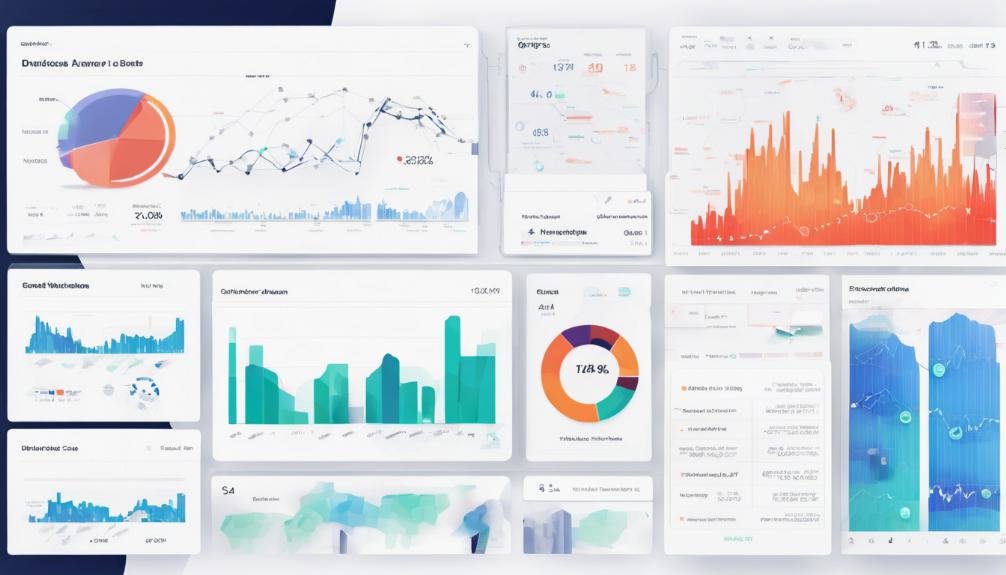AI in Descriptive Financial Analytics
In the domain of financial analytics, the integration of AI has ushered in a new era of efficiency and precision in deciphering intricate data patterns. By harnessing the power of artificial intelligence, organizations can unravel complex financial insights with unparalleled accuracy and speed. However, the implications of this technological advancement go beyond mere data analysis; they pave the way for a transformative shift in how financial decisions are made. The intersection of AI and descriptive financial analytics holds the promise of tapping into untapped potential and reshaping traditional approaches to financial management.
Key Takeaways
- AI enables in-depth analysis of financial data for trend identification.
- Descriptive analytics with AI provides historical insights for decision-making.
- AI algorithms process data for visual representations and trend visualization.
- Machine learning enhances anomaly detection and fraud prevention in financial data.
- Real-time financial insights are generated through AI-powered descriptive analytics.
Evolution of Financial Reporting
The evolution of financial reporting can be traced back to the early days of commerce when rudimentary forms of record-keeping were utilized to track financial transactions. Over time, advancements in technology have revolutionized the way financial data is managed and analyzed.
Historical data analysis plays a pivotal role in understanding past performance, trends, and patterns, enabling businesses to make informed decisions based on predictive modeling.
Financial statement interpretation is a key aspect of modern financial reporting, where data-driven decision making is heavily emphasized. By analyzing financial statements and extracting valuable insights, organizations can gain a deeper understanding of their financial health, performance, and potential risks.
This interpretation of financial data allows for more strategic planning, risk management, and resource allocation.
Enhanced Data Visualization Techniques
As organizations continue to harness the power of data analytics in financial reporting, the adoption of enhanced data visualization techniques has emerged as a critical strategy for conveying complex financial insights in a clear and actionable manner.
Interactive dashboards play a pivotal role in this process by allowing users to interact with data dynamically, enabling deeper exploration and understanding of financial information. These dashboards facilitate real-time data interpretation, empowering decision-makers to identify trends, anomalies, and correlations swiftly.
With enhanced data visualization techniques, organizations can transform raw financial data into visually appealing and easy-to-understand charts, graphs, and heat maps. This visual representation enhances the communication of financial performance, risks, and opportunities across various stakeholders within the organization.
By incorporating interactive elements such as filters, drill-down capabilities, and scenario analysis tools, users can investigate the data, uncovering valuable insights that drive informed decision-making processes.
Improved Forecasting Accuracy
The key to improved forecasting accuracy lies in enhanced trend analysis and real-time data processing.
By leveraging advanced AI algorithms, financial analysts can identify subtle patterns and correlations that may go unnoticed through traditional methods.
This approach enables organizations to make more informed decisions based on accurate and timely predictions.
Enhanced Trend Analysis
Utilizing advanced machine learning algorithms has greatly boosted the accuracy of trend analysis in financial forecasting, paving the way for enhanced predictive capabilities. Predictive modeling powered by sophisticated algorithms has revolutionized trend analysis, allowing for more thorough examination and analysis in the financial sector.
By leveraging statistical analysis and machine learning techniques, financial analysts can now explore deeper into historical data patterns, identifying trends that were previously challenging to uncover.
These advanced algorithms can process vast amounts of data at high speeds, enabling quicker and more accurate trend analysis. Through machine learning, the system can learn from past trends and behaviors to make informed predictions about future market movements.
This enhanced trend analysis not only provides more accurate forecasts but also helps in risk management and strategic decision-making for businesses in the financial industry.
Real-Time Data Processing
By integrating real-time data processing capabilities, financial analysts can enhance forecasting accuracy in the rapidly evolving landscape of the financial industry. This advancement allows for quicker decision-making and more precise predictions, giving organizations a competitive edge.
In this scenario, leveraging machine learning applications and predictive analytics becomes vital for extracting valuable insights from real-time data streams.
Three key aspects contribute to the improved forecasting accuracy through real-time data processing:
- Utilization of Data Mining Techniques: By employing advanced data mining techniques, financial analysts can uncover hidden patterns and trends in real-time data, enabling them to make more informed forecasts and decisions.
- Algorithm Optimization: Constantly optimizing algorithms that process real-time data enhances the accuracy of predictions. This optimization ensures that the models used for forecasting are up-to-date and relevant in the dynamic financial landscape.
- Integration of Predictive Analytics: Incorporating predictive analytics into real-time data processing enables analysts to forecast trends and outcomes with higher precision, ultimately leading to improved forecasting accuracy and better risk management strategies.
Anomaly Detection and Fraud Prevention
Anomaly detection and fraud prevention are essential components of financial analytics. Especially in a landscape where fraudulent activities continue to evolve in sophistication. Detecting unusual patterns and preventing fraudulent activities are key objectives. These can be efficiently achieved through AI-powered fraud detection systems.
Detecting Unusual Patterns
With the increasing integration of artificial intelligence into financial analytics, the ability to detect unusual patterns has become an essential component in safeguarding against fraudulent activities and anomalies. Leveraging advanced algorithms, AI systems excel in behavioral analysis and pattern recognition to identify deviations from normal trends.
Here are three key methodologies employed in detecting unusual patterns:
- Unsupervised Learning: AI algorithms can autonomously detect anomalies without the need for labeled training data. By clustering data points and identifying outliers, unsupervised learning can pinpoint irregular patterns indicative of potential fraud.
- Time-Series Analysis: This method involves analyzing data over time to uncover unusual fluctuations or trends. AI algorithms can compare current patterns with historical data to flag any deviations that may require investigation.
- Network Analysis: By examining complex relationships within financial transactions, AI can uncover suspicious connections and behaviors that might go unnoticed through traditional methods. Network analysis plays an essential role in identifying fraudulent activities orchestrated through intricate schemes.
Preventing Fraudulent Activities
Efficiently preventing fraudulent activities in financial analytics requires the implementation of advanced anomaly detection techniques and fraud prevention strategies. Behavioral analysis plays an essential role in identifying unusual patterns that may indicate fraudulent behavior.
By utilizing machine learning algorithms, financial institutions can analyze historical data to detect deviations from normal customer behavior, flagging suspicious activities for further investigation.
Transaction monitoring is another key component in fraud prevention. Real-time monitoring of transactions allows for the immediate detection of irregularities, such as unexpected large transfers or unusual spending patterns.
By integrating risk assessment models into the monitoring process, organizations can assign risk scores to transactions based on various factors, enabling the prioritization of high-risk activities for closer scrutiny.
Incorporating these advanced techniques into financial analytics not only enhances fraud prevention capabilities but also minimizes the potential impact of fraudulent activities on businesses and customers.
Ai-Powered Fraud Detection
Utilizing artificial intelligence (AI) in financial analytics for fraud detection involves leveraging advanced algorithms and technologies to identify suspicious activities and prevent fraudulent behavior effectively.
Machine learning plays an essential role in enhancing fraud detection capabilities by enabling systems to learn from data patterns and detect anomalies that could indicate potential fraudulent activities.
Key Aspects of AI-Powered Fraud Detection:
- Anomaly Detection: Machine learning algorithms are utilized to identify outliers and anomalies in financial transactions that deviate from typical behavior, flagging them for further investigation.
- Risk Assessment: AI-powered fraud detection systems assess the risk associated with each transaction or activity based on historical data, behavioral patterns, and other relevant factors to prioritize suspicious cases for review.
- Continuous Learning: These systems continuously learn and adapt to new fraud patterns and techniques, improving their accuracy and efficiency in detecting fraudulent activities over time.
Real-time Financial Insights
Real-time financial insights provide immediate and up-to-date data analysis for informed decision-making in the dynamic world of finance. By leveraging predictive analytics and machine learning, organizations can extract valuable information from vast datasets in real-time. This allows for quick data interpretation and predictive modeling, enabling financial professionals to stay ahead of market trends, identify potential risks, and seize opportunities promptly.
Predictive analytics algorithms process historical and real-time data to forecast future trends and behaviors. Machine learning algorithms continuously learn from new data, enhancing the accuracy of predictions over time. This real-time analysis empowers financial institutions to make agile decisions based on the most current information available.
Moreover, predictive modeling techniques can be applied to various financial aspects such as stock prices, customer behavior, and risk assessment. With real-time financial insights, organizations can adapt swiftly to changing market conditions, optimize investment strategies, and mitigate risks effectively. The immediacy and accuracy of these insights make them invaluable tools in today's fast-paced financial landscape.
Automation of Manual Processes
In the domain of real-time financial insights, the automation of manual processes plays a pivotal role in streamlining operations and enhancing efficiency within financial institutions. By leveraging technology to automate tasks that were previously performed manually, organizations can achieve significant improvements in their operational workflows and overall productivity.
Here are three key ways in which automation of manual processes benefits financial institutions:
- Reduced Errors: Automation helps minimize human errors that can occur during manual data entry or calculations. This reduction in errors leads to more accurate financial reporting and decision-making processes.
- Faster Processing: Automated systems can process large volumes of data at a much faster pace than manual methods. This increased speed enables financial institutions to generate insights and reports in real-time, allowing for quicker responses to market changes.
- Cost Savings: By automating repetitive tasks, financial institutions can save on labor costs and allocate resources more efficiently. This cost-effectiveness contributes to the overall profitability of the organization while maintaining high levels of accuracy and compliance.
Tailored Financial Recommendations
Tailored financial recommendations in the domain of descriptive financial analytics involve the personalized guidance and advice provided to clients based on their unique financial goals, risk tolerance, and investment preferences.
Through the utilization of advanced algorithms and data analysis techniques, AI systems can generate personalized insights and predictive recommendations tailored to individual clients.
These recommendations go beyond generic advice and instead offer customized strategies that align with the client's specific financial objectives and constraints.
Regulatory Compliance Solutions
Advanced AI-powered systems in the domain of financial analytics offer all-encompassing solutions for ensuring regulatory compliance within the financial industry. These systems utilize various technologies and algorithms to streamline compliance processes and enhance overall efficiency.
Here are three key components of regulatory compliance solutions powered by AI:
- Risk Mitigation Strategies: AI can analyze vast amounts of data to identify potential risks and anomalies, enabling financial institutions to proactively implement risk mitigation strategies. By utilizing machine learning algorithms, these systems can predict potential compliance issues before they escalate, thereby minimizing risks for the organization.
- Compliance Monitoring: AI-powered systems can continuously monitor regulatory changes and updates, ensuring that financial institutions remain compliant with the latest laws and regulations. Through intelligent alert systems, these solutions can promptly notify relevant stakeholders of any regulatory changes that may impact the organization, allowing for timely adjustments to be made.
- Automated Reporting Solutions: AI streamlines the reporting process by automating data collection, analysis, and generation of compliance reports. This not only saves time and resources but also reduces the likelihood of human error in reporting, ensuring accuracy and reliability in compliance documentation.
Conclusion
To wrap up, the integration of AI in descriptive financial analytics is akin to a powerful magnifying glass, enabling organizations to explore deeply into their financial data and extract valuable insights with precision and accuracy.
From enhanced data visualization to real-time financial insights, AI-driven systems revolutionize the way businesses analyze and interpret their financial information.
By leveraging advanced algorithms and machine learning techniques, organizations can make informed decisions, improve forecasting accuracy, and guarantee regulatory compliance in today's dynamic financial landscape.







